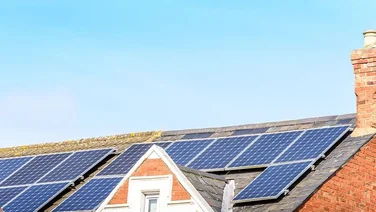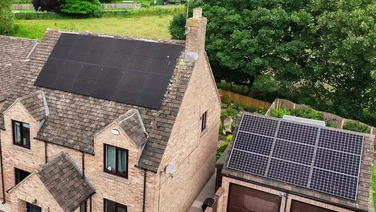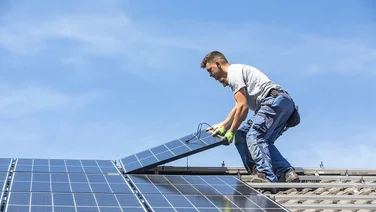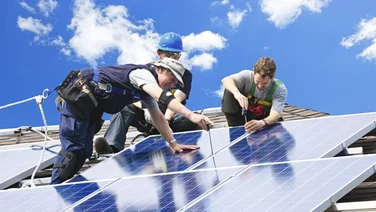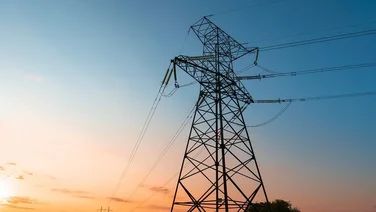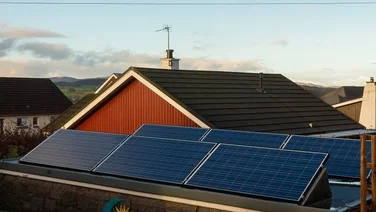- What are vertical solar panels?
- Do vertical solar panels actually work?
- Vertical solar panel output vs normal solar panel output
- What are the benefits of vertical solar panels?
- How much do vertical solar panels cost?
- Is your home suitable for vertical solar panels?
- How are vertical solar panels installed?
- Do you need planning permission for vertical solar panels?
- Are vertical solar panels worth it?
- Next steps
- Vertical solar panels: FAQs
- Vertical solar panels are more effective at absorbing sunlight in winter months
- Bifacial vertical panels are up to 7 times more efficient than roof-mounted ones
- Installing vertical solar panels will be pricier than roof-mounted ones
Welcome to your one-stop guide for all things related to vertical solar panels, one of many different types of solar panel that cut emissions and help you save money.
Already interested in taking that curiosity one step further? Our experts can send you free, personalised solar panel quotes – just pop your details in here and we’ll be in touch with options to match your requirements.

What are vertical solar panels?
Vertical solar panels are just like regular solar panels, but instead of lying flat on a roof or ground, they stand upright – imagine a billboard beside a dual carriageway, but instead of an ad, it’s filled with solar photovoltaic (PV) cells.
In countries like the UK, which are further from the equator, the sun doesn’t shine directly overhead but comes in at an angle, especially during winter. Standing tall, vertical solar panels can catch this sunlight more effectively.
Do vertical solar panels actually work?
The answer is a resounding yes.
Vertical solar panels aren’t just a novelty – they’re a functional alternative to traditional solar panels depending on the location and specific needs. Various installations around the world have proven to be just as effective, if not more so, than their horizontal counterparts.
Take Manchester’s CIS Tower, for example. Retrofitted with 7,244 solar panels, it generates 390 kW (kilowatts) of energy per year, enough to power 55 average-sized homes. This transformation makes it a key solar installation in the UK and shows how older structures can embrace modern renewable technology.
On the mainland, an Oslo-based startup called Over Easy deployed a vertical bifacial (effectively double-sided) rooftop PV system in 2022 that outperformed similar conventional systems by 30%, generating 1,070 kWh (kilowatt-hours) in its first snowy winter.
Even further afield, in Melbourne, the 48-story Paragon Tower features Australia’s largest vertical solar PV system. By occupying 158 m² of otherwise unused space, this 42 kW system provides not only energy but also cost savings for residents and developers.
Vertical solar panel output vs normal solar panel output
According to a recent German study, bifacial vertical solar panels are seven times more efficient than normal roof-mounted solar panels because they can catch the sun any time of the day.
With that being said, wall-mounted vertical solar panels (with only one side facing the sun) will typically produce less energy than traditionally angled panels, since they’re limited in terms of location and may not always directly face the sun’s path.
The difference in solar panel output can vary based on your location and the season. As mentioned earlier, the sun is lower in the sky in the winter, so a south-facing wall-mounted panel will get more exposure than a roof-mounted panel in the colder months.
Want to compare makes and models? Head to our Best Solar Panels page for a rundown of the top options on the market.
What are the benefits of vertical solar panels?
- Less surface area exposed to dust, debris and droppings.
- Can be installed in limited spaces.
- More consistent power output during winter months.
- Modern and unique appearance.
Maintenance-wise, vertical solar panels are less likely to accumulate dust, debris and bird droppings, as well as sleet and snow in frosty regions. The upright design ensures that most things can easily slide off the panel surface, preventing potential interruptions to energy generation.
When space is tight, going vertical can also save valuable space. Vertical solar panels can fit in narrow spaces where traditional flat panels can’t, such as between buildings, which makes them a versatile choice for a wide range of settings.
Lastly, aesthetics matter. Vertical solar panels are a great way to add a touch of modern style and practicality to any design, especially if you want to give your home a contemporary vibe while showing that you care about the environment.
How much do vertical solar panels cost?
Please note that the table below lists the costs of solar panels installed in a traditional way. Bear in mind that installing vertical solar panels will be pricier than roof-mounted ones because of the installation complexity, so expect the prices to be a little higher than those listed below.If you’re going for wall-mounted solar panels, they’ll need special wall anchors for safe vertical installation, plus scaffolding.
For more information on what you can expect to pay, visit our solar panel costs page.
| Household size | Number of solar panels | Average cost |
|---|---|---|
1-2 bedroom house | 6 panels | £4,216 |
3 bedroom house | 10 panels | £7,026 |
4-5 bedroom house | 14 panels | £9,837 |

Is your home suitable for vertical solar panels?
Here’s how you can determine if vertical solar panels are a good fit for your home:
- Orientation: The angle and direction of solar panels is important. Homes with south-facing walls are ideal because they get sunlight throughout the day, but check that other structures or trees won’t overshadow them.
- Wall space: Larger walls can accommodate more panels, but usually, you can fit only two to four panels on one wall. To fully meet a typical three-bedroom home’s energy needs, you’ll need around 10 solar panels.
- Structural integrity: A structural engineer will need to assess whether your walls will be sturdy enough for installation before any work.
- Historical considerations: Solar panels on listed buildings are unlikely to be possible because of aesthetic concerns and development restrictions (more on that below).
Vertical solar panels are a stylish, innovative choice for energy collection, especially if your home has a large, unshaded south-facing wall. However, space limitations might mean a vertical installation can’t meet an entire household’s energy demands alone.
Before you decide, we recommend consulting a reputable solar installation company who can assess your home’s suitability and guide you through the installation process.
How are vertical solar panels installed?
The process of installing vertical solar panels is much like setting up traditional roof-mounted ones. Start by picking a sunny, south-facing spot on your home, ensuring there’s no shading from trees or nearby buildings.
Once you’ve got the right location, your solar installer will attach the panels to a cleverly designed frame and will link them up to a solar inverter to transform the sunlight into electricity for your home.
Do you need planning permission for vertical solar panels?
Most times, installing vertical solar panels doesn’t require planning permission thanks to permitted development regulations introduced in 2008, which allow simpler and quicker solar panel installations with no need for formal approval.
However, it’s always a good idea to check local ordinances or rules, especially if you live in a listed building or a conservation area, where restrictions still apply.
Are vertical solar panels worth it?
Vertical solar panels can be a worthwhile investment, but it depends on specific circumstances like your building orientation, local climate and potential wall space.
In certain conditions, they can be just as effective as traditional rooftop panels and even offer unique advantages like better performance during the winter. However, you might not be able to rely on them to fully replace the energy output of a full rooftop solar installation.
We always recommend talking to a professional to consider your options before you take the plunge.
Next steps
From their benefits to costs and planning permissions, we hope this guide has illuminated the path to making an informed decision on whether vertical solar panels could be a good fit for your needs.
Let’s get you started on your next steps toward a greener future. Fill out our quick web form to get your free, tailored solar panel quotes.
Vertical solar panels: FAQs
Are vertical solar panels effective?
Vertical solar panels are effective and have been successfully deployed in various settings, from urban skyscrapers to snowy terrains.
While they might not fully match the energy output of traditional rooftop systems, they offer the ability to use otherwise wasted space.
Can you put solar panels on a vertical wall in the UK?
In the UK, you can install solar panels on a vertical wall, often without planning permission due to permitted development regulations (with a few exceptions).
Vertical installations are a viable option when you have limited or unsuitable roof space, especially on large, south-facing walls that receive ample sunlight throughout the day.
Do solar panels work better vertically or horizontally?
Horizontal solar panels capture more sunlight because of their optimal angle toward the sun, making them more efficient for most homes.
However, vertical panels can perform better in specific situations like high-latitude locations or during winter months when the sun is lower in the sky.


